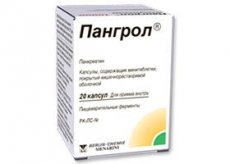Medical expert of the article
New publications
Preparations
Pangrol
Last reviewed: 03.07.2025

All iLive content is medically reviewed or fact checked to ensure as much factual accuracy as possible.
We have strict sourcing guidelines and only link to reputable media sites, academic research institutions and, whenever possible, medically peer reviewed studies. Note that the numbers in parentheses ([1], [2], etc.) are clickable links to these studies.
If you feel that any of our content is inaccurate, out-of-date, or otherwise questionable, please select it and press Ctrl + Enter.

Pangrol has proteolytic, lipolytic, and amylolytic properties. It is used to compensate for the deficiency of pancreatic enzymes.
 [ 1 ]
[ 1 ]
Indications Pangrol
Pangrol can be used as a replacement drug for exocrine pancreatic insufficiency of various origins: in chronic pancreatitis, and also in pancreatectomy, dyspepsia, cystic fibrosis, and also in the period after radiation procedures. The cause may also be bloating or diarrhea of non-infectious origin.
In addition, the medicine is indicated for eliminating various disorders in the process of food absorption (after gastric resection surgery together with the small intestine). It also helps to digest fatty or plant foods that are difficult to digest (or unusual for the body) with a sedentary lifestyle. It is used to eliminate disorders in the work of the masticatory apparatus and with prolonged immobility.
It is used to treat Remheld syndrome, and also in the preparatory period before X-ray and other examinations of the peritoneum (to perform intestinal degassing).
Release form
Available in capsule form. One polypropylene jar contains 20 or 50 capsules, as well as silica gel (desiccant). One package contains 1 jar of capsules.
Pharmacodynamics
The main active component of the drug is pancreatin (digestive enzyme). This component takes part in the process of digestion of proteins and fats with carbohydrates. The medicinal activity is due to the activity of enzymes that are part of the drug (trypsin and lipase, and in addition, amylase with chymotrypsin). The most important value in the treatment process is the functional activity of lipase, as well as the content of the substance trypsin. But the amylolytic properties of the drug are relevant only in the elimination of cystic fibrosis.
Pancreatic enzymes stabilize digestion processes and also help improve the functional activity of this system. Trypsin is able to inhibit the excretory activity of the pancreas and also have an analgesic effect.
Pharmacokinetics
The capsule shell is acid-resistant, which protects the enzymes from the effects of hydrochloric acid (as the capsule passes through the stomach). The shell dissolves in the small intestine, releasing the enzymes. They reach peak activity 40-45 minutes after oral administration.
 [ 4 ]
[ 4 ]
Dosing and administration
The medicine does not need to be chewed – it should be washed down with water or juice (1 glass). If necessary, it is allowed to open the capsule with mini-tablets inside, and then dissolve its contents in a glass of liquid.
Dosages of Pangrol are selected individually, in relation to the severity of the digestive disorder. Usually it is recommended to drink it before meals in the amount of 1-2 pieces (for Pangrol 20,000 or 25,000) or 2-4 pieces (for Pangrol 10,000). The dose can be increased only with the doctor's prescription, depending on the severity of the digestive disorder.
Children over 12 years of age and adults are allowed to consume no more than 15-20 thousand U/kg of lipase per day; in case of absolute exocrine insufficiency, 400 thousand U are taken per day.
The dosage of the drug, as well as the duration of treatment for children aged 3-12 years, should be selected by the attending physician. Usually, the dosage for a child is calculated in the ratio of a maximum of 1500 U/kg of lipase. Children under 1.5 years are prescribed 50 thousand U per day, and at the age of over 1.5 years, the dosage is 100 thousand U.
 [ 5 ]
[ 5 ]
Use Pangrol during pregnancy
During this period, Pangrol is prescribed only in those situations where the expected positive effect on the mother’s condition exceeds the possible development of negative consequences for the fetus.
Contraindications
Contraindications include: acute pancreatitis or exacerbation of its chronic form, as well as individual intolerance to the components of the drug.
Side effects Pangrol
As a result of taking the medicine, the following side effects may be observed: gastrointestinal disorders (such as diarrhea or constipation, nausea, pain in the epigastrium).
As a result of prolonged use of high doses of drugs, hyperuricosuria may develop.
In patients with cystic fibrosis, taking high doses of the drug may cause narrowing in the ileocecal valve or inside the ascending colon.
Storage conditions
Pangrol must be kept at a temperature that does not exceed 25 degrees.
 [ 8 ]
[ 8 ]
Shelf life
Pangrol is allowed to be used for 2 years from the date of manufacture of the drug. But after opening the package, the shelf life is no more than six months.
Attention!
To simplify the perception of information, this instruction for use of the drug "Pangrol" translated and presented in a special form on the basis of the official instructions for medical use of the drug. Before use read the annotation that came directly to medicines.
Description provided for informational purposes and is not a guide to self-healing. The need for this drug, the purpose of the treatment regimen, methods and dose of the drug is determined solely by the attending physician. Self-medication is dangerous for your health.

